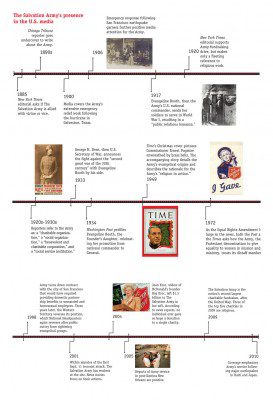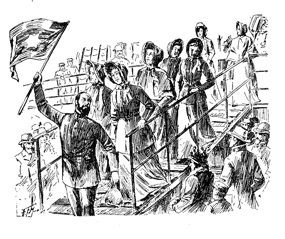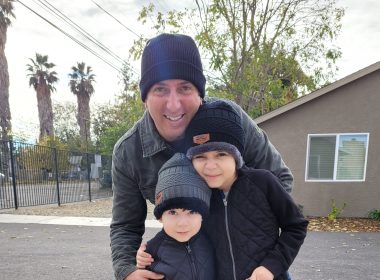 From 1880 to World War I, the vast majority of Americans, those who did not come into contact with its street evangelism or were not direct beneficiaries of its services, knew about The Salvation Army through newspapers and magazines. Much of what they read was negative. The Army was portrayed as a movement of over-enthusiastic rabble-rousers who confused sensationalism with evangelism. Was the Army allied with virtue or vice, an 1885 New York Times editorial asked and then answered, “The Salvation Army appears to be organized for the purpose of applying the methods of the variety show to Christianity. It undertakes to minister to the same craving for vulgar modes of excitement.”
From 1880 to World War I, the vast majority of Americans, those who did not come into contact with its street evangelism or were not direct beneficiaries of its services, knew about The Salvation Army through newspapers and magazines. Much of what they read was negative. The Army was portrayed as a movement of over-enthusiastic rabble-rousers who confused sensationalism with evangelism. Was the Army allied with virtue or vice, an 1885 New York Times editorial asked and then answered, “The Salvation Army appears to be organized for the purpose of applying the methods of the variety show to Christianity. It undertakes to minister to the same craving for vulgar modes of excitement.”
Newspapers disparaged Army parades, decried its female preachers and derided its use of popular culture. Even when positive stories on slum ministries appeared in the 1890s, reporters mocked its fervent followers. When a Chicago Tribune reporter went undercover to write about the Army, she admitted at the outset that her subjects seemed “a class of fanatics, bizarre and picturesque, and exciting only wonder and ridicule.”
She signed up with a small corps in a working-class Chicago suburb and, to her surprise, was inspired by the commanding officer’s beauty, compassion and grace. But when she was transferred to another corps, she found coarse recruits yearning for worldly pleasures and an unattractive captain who falsified her financial records.
 Critics frequently questioned the Army’s finances, demanding to know where its money went and whether its account ledgers could be trusted. They accused Army officers of investing in a mining company (which some did) and charged Salvationist leaders with using funds collected for social work to support its soul-saving crusades (which appears to be untrue). By the turn of the century, the Army found support among advocates of social Christianity, a movement to apply religious principles to social problems. But secular philanthropists, committed to scientific methods of charity, castigated Salvationist philosophy and programs as sentimental and unempirical.
Critics frequently questioned the Army’s finances, demanding to know where its money went and whether its account ledgers could be trusted. They accused Army officers of investing in a mining company (which some did) and charged Salvationist leaders with using funds collected for social work to support its soul-saving crusades (which appears to be untrue). By the turn of the century, the Army found support among advocates of social Christianity, a movement to apply religious principles to social problems. But secular philanthropists, committed to scientific methods of charity, castigated Salvationist philosophy and programs as sentimental and unempirical.
These and other critics were silenced by the Army’s outreach during the 1900 hurricane in Galveston Texas and the 1906 San Francisco earthquake. Galveston was the first occasion for extensive Army emergency relief, and its subsequent work in San Francisco garnered further positive attention. Although California Salvationists had not been prepared for widespread property damage and consequent human need, they had jumped into action with a zeal and determination that impressed the local citizenry and was widely and favorably reported.
Evangeline Booth may have had in mind the Army’s past success at large-scale relief work when she decided, a decade later, to send her soldiers to serve in World War I. Despite the modest scale of their efforts, Salvationists reaped a public relations bonanza that culminated in an unprecedented ability to raise money and command media attention. Widely popular, [The Salvation Army was] praised in poetry and song, newspaper reports and letters from the front. A good deal of that attention was directed at Army lassies [Army members who made and served donuts to World War I soldiers], the once reviled now revered symbol of the organization.
The media depicted lassies as vibrant and appealing, but their religion was less so, inverting the emphasis that the Army would have preferred. News reports on the lassies’ work—whether frying donuts on the front lines or tending slum children at home—was central to the Army’s transformation from evangelical outcast to humanitarian icon. Following the familiar Mary/Martha trope that valued women who were silent servants above those who were loquacious leaders, Army lassies embodied a deed-over-creed faith that was old-fashioned in its practice but modern in its pluralist and activist orientation. It fit the postwar era and reflected journalism’s own notions about what religion should be.
Throughout the 19th century, newspapers had reflected a positive view of religion, albeit as an element of a universe circumscribed by evangelical Protestantism. Tall steeple ministers were frequent editorial commentators, particularly when their perspectives on social issues coincided with those of publishers. Within that context, reporters unmasked religious scamps and scalawags but deviance, like The Salvation Army’s “sensationalism,” underscored a normative view of Christianity as a civilizing and stabilizing influence on society. After the Civil War, however, innovations in science, advances in scholarship and changes in society began to loosen religion’s grip on the public imagination. A secularist tide took hold of the professions and its influence was felt both in news coverage and in the journalism profession more generally.
The Army through the decades
For many journalists, the post-World War I Salvation Army exemplified religion’s role in the new era insofar as it could be portrayed as a nonsectarian, activist faith, the Army represented the kind of Christianity that newspapers liked. Gone were references to raucous revivals and street corner services, replaced by stories of slum nurseries and soup kitchens. Throughout the 1920s and 1930s, reporters referred to the Army as a “charitable organization,” a “social organization,” a “benevolent and charitable corporation,” and a “social service institution.” Articles described its shelters, salvage work, summer camps and Christmas dinners—interspersed with profiles of leaders and lassies. A 1920 New York Times editorial, supporting a fundraising drive, made only a fleeting reference to the Army’s religious work.
Even when the group’s religiosity was noted, it was linked to service provision: “Its militant evangelism has been a central part of its character since its beginnings in this country in 1880. So has the intensely practical aid which it brings to every type of misery with which it comes into contact.” A 1934 Washington Post profile of Evangeline Booth, the Founder’s daughter, celebrated her promotion from head of the American Army to commander of the worldwide Army. The story notes her fundraising and organizational skills; her physical attributes and daily activities; her acting and hymn-writing abilities but says nothing about her personal beliefs or the religious mission of the global denomination that she would soon lead.
The close fit between the activist faith and the spirit of the times was evidenced in reporting on the Great Depression. The Army’s brand of humanitarian activism resonated with national calls for service. In 1933, when George H. Dern, the U.S. Secretary of War, announced the fight against the “second great war of the 20th century,” Evangeline Booth was by his side. Addressing an Army fundraising rally at the Seventh Regiment Armory in New York City, Dern called for defensive lines against “hunger, misery, nakedness and privation,” noting, “of those defensive lines, moreover, none is of greater importance than those which are manned by the troops of The Salvation Army.”
By mid-century, staid men had replaced winsome lassies as the Army public image. The apotheosis of the change was Time magazine’s 1949 Christmas cover, picturing Army Commissioner Ernest Pugmire, grey-haired and bespectacled, enwreathed by brass bells. The accompanying story explicitly detailed the movement’s evangelical origins with a historical sketch of the Booths. Unlike most newspaper stories, the newsmagazine described the rationale for the Army’s “religion in action,” noting, “It proceeds on the down-to-earth theory that Christ gave clear instructions on what to do about the degraded, the abandoned and the poor…Booth was after men’s souls and his principal weapon was evangelism. The modern army still fights that war, but now its principal weapon is charity.”
According to Time, the Army sacrificed its old-timey enthusiasms for public support and respectability and “the kind of social welfare program over which Ernest Pugmire presides is a sounder attack against the enemy than all the processions General Booth might lead…and sounder than street-corner revivals.”
The press paid increasing attention to Salvationists’ faith during the 1970s. Religion coverage had experienced a renaissance: the 1976 election of Jimmy Carter brought evangelicals into the American political arena, and the 1978 Iranian Revolution and subsequent 444-day-long American hostage crisis, did the same for Muslims. But unlike religious movements that engaged in affairs of the state, the Army was depicted as apolitical and charmingly picturesque.
Reporting on the Army became an integral part of the news media’s rediscovery of religion. Stories still covered the nuts and bolts of fundraising appeals, Christmas kettles and leadership changes, but also included an ethnographic dimension that explored the intersection of belief and behavior. Unlike the 19th century press, which portrayed a sensational ministry motivated by a scandalous sensibility, 20th century reporters depicted a quaint relic from a bygone era. When women’s equality and the fight for the Equal Rights Amendment loomed large in the news, both the Post and the Times asked how the Army, the first Protestant denomination to give equality to women in mission and ministry, treated its distaff members today. According to the Times, “husband and wife are really equal,” yet the movement’s strict rules (couples must receive permission to marry and wed in uniform; women took their husband’s rank never vice versa; women worked mainly in women’s ministries) mitigated against a progressive interpretation of the faith.
Taking hits
Increased media attention to the interplay between religion and politics led to new types of stories about the Army. Standard holiday pieces on bell-ringers still appeared, but so did news on contested social issues. Even when the Army won the day, coverage drew attention to its conservative social and political positions. The Army’s evangelicalism, or to some its fundamentalism, became relevant because of public as well as governmental support for its programs. Avoiding controversy was often impossible as in 1998 when the Army turned down a contract with the city of San Francisco because it would have required providing domestic partnership benefits to unmarried and homosexual employees.
The decision forced cutbacks in services to seniors, drug addicts and the homeless—as well as the loss of 60 staff positions. Three years later, the Army’s Western Territory switched its position, agreeing to provide benefits. But a loud and very public outcry from rightwing evangelical groups induced the Army’s National Headquarters to reverse its reversal. According to local coverage, the rescission had ramifications far beyond the Army’s position on gays. A local official told the San Francisco Chronicle, it was a “mean-spirited move” aimed at pleasing the religious right, “ ‘not just domestic partners, but grandparents, adult children, and others who are living with Salvation Army employees may remain without health coverage.’ ”
The Army also took a hit when newspapers reported it paid workers at its facilities below the minimum wage. Although the Army countered that the workers were “clients” who worked as part of their treatment program, the U.S. Labor Department ordered it to obey the law. “Department of Labor officials see this as a question of equity and fairness,” reported the Times. “They say that The Salvation Army’s practice of providing only a small reimbursement for work and no overtime, combined with poor record keeping, amount to a kind of exploitation of workers.”
The Army mounted a behind-the-scenes campaign and within days, the government changed its policy, allowing the substandard pay scale to stand. The Army likewise scored a mixed win when the U.S. Department of Housing and Urban Development permitted a picture of Jesus to hang in a Connecticut shelter, despite a ban on religious decorations in federally financed projects.
New media, new millennium
Perhaps mitigating against mainstream news’ negative coverage of the Army was its front and center role in providing disaster relief. Less than two months after the Post revealed the secret deal between the Army and the White House, terrorist attacks on Sept. 11 reframed news stories on religion and politics.
The destruction wrought by al-Qaeda pushed aside domestic quarrels over the role of the religious right, at least for a while. The immediate needs at Ground Zero, the former site of the World Trade Center, focused both the religious and the relief communities on finding the dead, helping the living and supporting those who were tasked with an enormous clean-up effort.
Within minutes of the first plane crash, The Salvation Army had workers at the site. Salvationists provided meals for the clean-up crews and offered emotional and spiritual counseling for survivors. As in the past, news stories glossed over the organization’s evangelical beliefs, focusing instead on their actions. In addition to downplaying religion, coverage was generally positive. Reporting on Army efforts in post-Katrina New Orleans and in Haiti following the 2010 earthquake similarly emphasized service delivery rather than religious mission.
But the movement’s faith-based outreach also remained in the headlines. In 2004, Joan Kroc, the widow of McDonald’s founder Ray Kroc, left $1.5 billion to the group in her will. It was the largest gift of its kind: according to news reports no individual ever gave as large a donation to a single charity. Associates said Mrs. Kroc appreciated the Army’s ability to provide services even though she did not share its religious views. As the Times explained, the Army was “run by ordained ministers and has a quiet but strong evangelizing component to its activities, which has often placed it at the center of controversies about public financing.”
Subsequent coverage reported on the Army’s difficulties raising funds to match the Kroc bequest, which was targeted at creating state-of-the-art community centers, a goal that some Army leaders deemed tangential to their core mission.
Given newspapers’ shrinking news hole—as well as cultural changes about the role of religion in public life—contemporary coverage of the Army has focused less on the merit of its funding appeals and service provision and more on its incursions into matters of church-state separation.
Thus in the 21st century, a religion had hid its identity in plain sight was outed by a news media formerly colluded in the cover-up. News consumers now had ample opportunities to learn not only about The Salvation Army’s evangelical beliefs but also of their implications for the hiring, firing, benefits and salaries of non-Army employees engaged in its government-funded social service provision. News outlets also reported on the Army’s outreach, emergency relief and Christmas kettles (features tracked giving patterns as well as idiosyncratic gifts such as gold coins or very large bills), but the bulk of pieces were “gotcha” stories that caught the Army in church-state conflicts. Nevertheless, in 2009 the Army was, as it had been for most of the decade, the nation’s second largest charitable fundraiser, after the United Way.
Its status is not unique. Three of the top five charities in 2009 were religious, and public support for their work may well reflect the sensibility of a population that claims to be almost 80 percent Christian. The news media’s coverage of the Army as an evangelical mission may have strengthened its attractiveness at a time of increased religious awareness. According to several Army officers, the movement’s evangelical foundation appeal even to those who don’t share it. “Many of our donors appreciate we do this with a spiritual motivation,” said Commissioner Carol Seiler, who oversees Army work in 11 Midwestern states. “Joan Kroc didn’t give us $1.5 billion because she was aligned with our faith. She did it because she thought we were trustworthy.”
The Army’s example illuminates the challenges faced by religious groups that take government funds to provide social services. Religious entities must not only negotiate between secular regulations and religious doctrine, but they do so, at least in the 21st century, in full public view. The news media is the channel through which the public-at-large learns about the world and until very recently, its grip on information was total.
In the early 20th century, news managers, emboldened by a sense of mission and empowered by their hegemonic position, promoted an idea of religion that was devoid of theological specificity or creedal commitment. In search of a religion befitting a pluralistic, action-oriented society as well as one that would not challenge their own authority, they advanced the Army. The Army’s need to promote a non-sectarian image—its very survival depended on public support, made for a symbiotic match.
The Army may have allowed its identity to be hidden in plain sight, but its members never deviated from their fundamental mission. In 2011, as it was in 1880, The Salvation Army is “an evangelical organization dedicated to bringing people into a meaningful relationship with God through Jesus Christ.” Or, as a Salvationist might say, those with ears to hear and eyes to see will understand their mission, notwithstanding the twists and turns of a secular news media.













